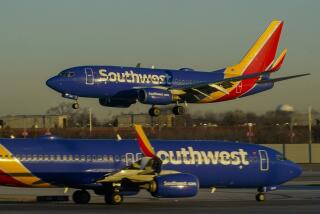Spirit Airlines tries to fix its image with comfier seats
Spirit Airlines, the low-cost airline that has reported the highest rate of passenger complaints, has spent the last few years improving customer service and now is trying something new: seats that the carrier touts as roomier and more comfortable.
Spirit Airlines Chief Executive Ted Christie unveiled the new seats Monday at an airline expo in downtown Los Angeles, saying they demonstrate the carrier’s commitment to budget-minded passengers.
“We are listening, that’s the message,” Christie said in an interview during the Airline Passenger Experience Expo. “We want to show them that we are interested in investing in our products in ways that they think would create value.”
The seats will be included in 60 new planes the airline plans to add to the fleet by 2021 and will be installed in 40 existing planes that will be retrofitted in the same time frame. The carrier now has a fleet of about 135 planes.
The move is part of a bigger effort by the Florida-based airline to re-create itself, about a dozen years after it launched with ultra-low fares but a long menu of fees for services such as printing out a boarding pass ($10) and upgrading to roomier seats ($25 to $175, depending on the length of the flight).
Although the fees helped the carrier collect some of the industry’s widest profit margins, Spirit Airlines’ service has also drawn the highest rate of passenger complaints.
The financial meltdown of 2008 forced every major U.S. airline to squeeze more seats into each cabin and add fees for services that were previously included in airfares, but Spirit Airlines took the focus on pinching pennies to new heights. Spirit even charges up to $35 to book a flight through a reservation agent.
Industry experts note that since the economic crisis, some of the major airlines have begun to spend extra on customer service, such as offering free snacks or free wireless internet for economy seat passengers. But they say they doubt that other carriers will follow Spirit Airlines’ lead by investing in bigger, roomier seats for fliers who book the cheapest seats.
“I don’t think the major carriers will change the way they approach the passenger in economy,” said Madhu Unnikrishnan, editor of the publication Skift Airline Weekly.
As part of its effort to repair its image, Spirit Airlines has dramatically improved its rate of on-time arrivals by adding more time in between flights to respond to unforeseen problems such as mechanical issues and staffing snafus. Improving on-time arrival rates not only helps to reduce passenger complaints, but saves on the cost the airline must pay staff in overtime or to rebook passengers on delayed flights, among other expenses.
The new seats built by Britain’s Acro Aircraft Seating will include “memory foam” to make them more comfortable and a design that replaces a flat backrest with a concave seat back. Christie says the seat back is ergonomically designed to give passengers more lumbar support and also adds up to an inch and a half of legroom per seat.
Spirit Airlines has traditionally had among the most cramped seats in the industry, with legroom, typically measured as the distance from the back of one seat to the same spot on the next seat in front, of about 28 inches. With the new design, Spirit’s new seats will offer about 30 inches of legroom.
Like the current seats on Spirit Airlines planes, the new seats are not adjustable, but have been reclined back an extra inch, Spirit officials said. In addition, the middle seat in the economy section of the plane will be about an inch wider, making the least desirable seat on the plane at least a bit more tolerable.
“The running joke in the traveling space is that nobody wants the middle seat,” Christie said. “But what we’ve done is created a bit more space for the people in the middle seat.”
Despite the changes, Christie said, each cabin will be able to hold the same number of passengers so as not to affect the carrier’s bottom line.
“The density of airplane will be exactly the same,” he said.
A few years ago, Spirit had the highest profit margin in the industry, in part because of the revenue it generated from bag fees and charges for food, drinks and traveling with pets, among other costs.
But since the carrier began focusing on customer service over the last year or two, Spirit Airlines’ income excluding special items rose to $300.9 million in 2018, compared to $291 million in 2016. In that same period, the net income margin dropped to 13.5% from 19%, according to Spirit Airlines earnings reports.
Christie warned against comparing profit margins over the last few years, saying lower margins are primarily due to other factors, including higher fuel prices.
“We have routinely shown we can be high-efficiency, high-value and still have one of the largest margins in the business,” he said.
More to Read
Inside the business of entertainment
The Wide Shot brings you news, analysis and insights on everything from streaming wars to production — and what it all means for the future.
You may occasionally receive promotional content from the Los Angeles Times.










